Following a seven-month journey, NASA’s Perseverence Rover touched down at Mars’s Jezero Crater on February 18, 2021. Since then, mission controllers have made a lot of progress, including capturing the planet’s sounds, driving on the rocky, craters of the red terrain for the first time, and transmitting over 7,000 images from the most advanced suite of cameras ever to travel to the Red Planet.
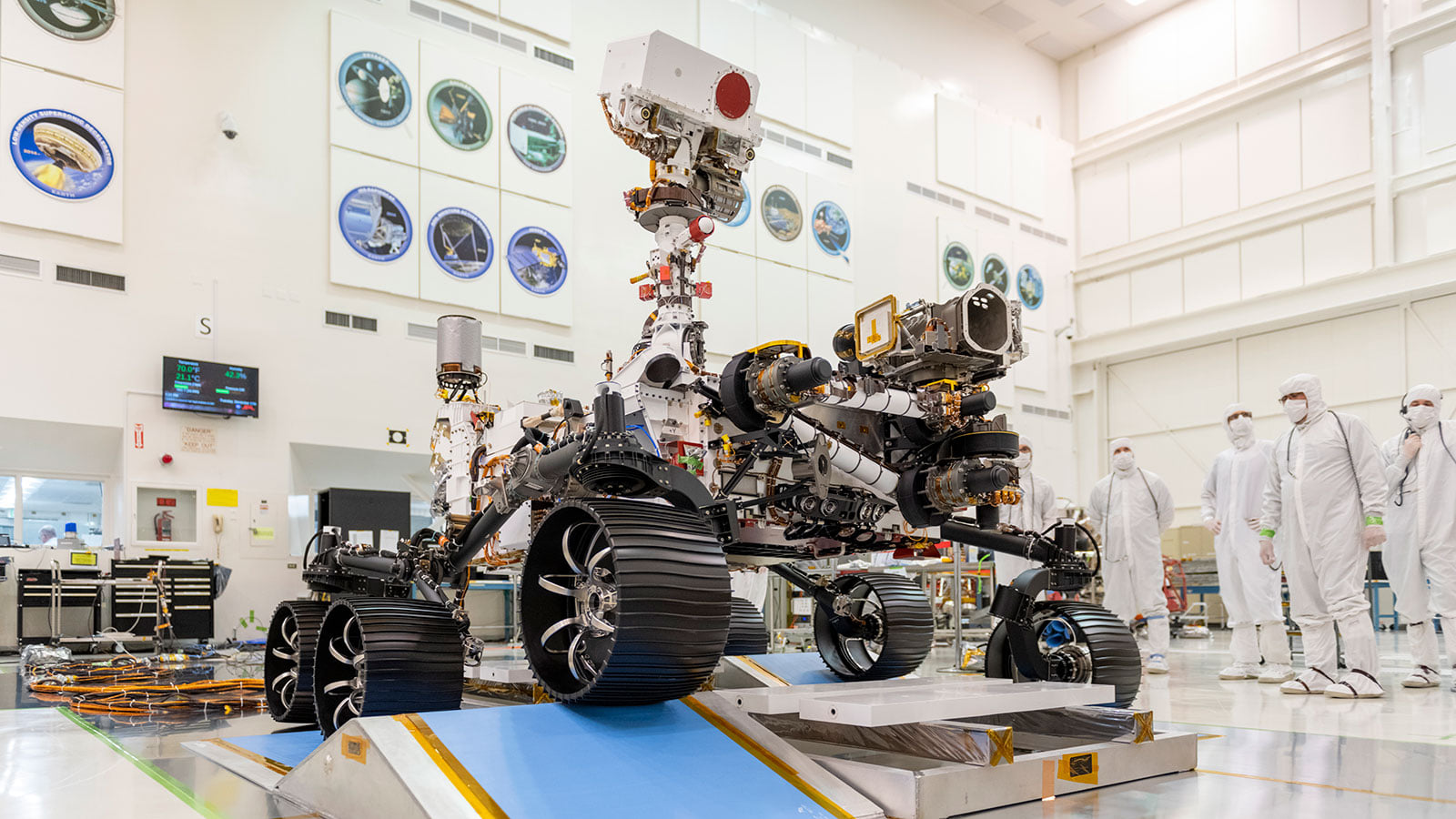
The Mars Perseverance has an identical rover twin hard at work on Earth. OPTIMISM is a full-scale engineering version of the Mars-bound rover. It is used to test hardware and software before commands are sent to Perseverance. Image courtesy of NASA/JPL-Caltech.
After a recent virtual briefing with NASA experts to discuss upcoming milestones, we learned that the experimental helicopter Ingenuity, which remains attached to the belly of the rover, is preparing for its first flight. The agency is targeting no earlier than April 8, 2021, for the 4-pound rotorcraft to make the first attempt at a powered, controlled flight of an aircraft on another planet and in the fragile Mars atmosphere. Eventually, this first “hovering” activity will be followed by additional experimental flights of incrementally farther distance and greater altitude.
After a month on Mars, Perseverence, which is equipped with 3D printed parts, is progressing as planned. Several exciting milestones have already proven the car-sized robot’s resilience as it prepares to carry out scientific goals. This includes testing technologies that would help sustain an interplanetary human presence or collect rock and soil samples to bring back to Earth.
Among the seven instruments that the rover is carrying is the Planetary Instrument for X-ray Lithochemistry (PIXL), a lunchbox-sized device that will seek out signs of fossilized microbial life by shooting X-ray beams at rock surfaces to analyze them. PIXL is not only crucial for finding traces of life on rock features as small as a grain of salt, but it is relevant on a manufacturing level as well, considering the 10-pound lab tool has five 3D printed parts incorporated into its structure.
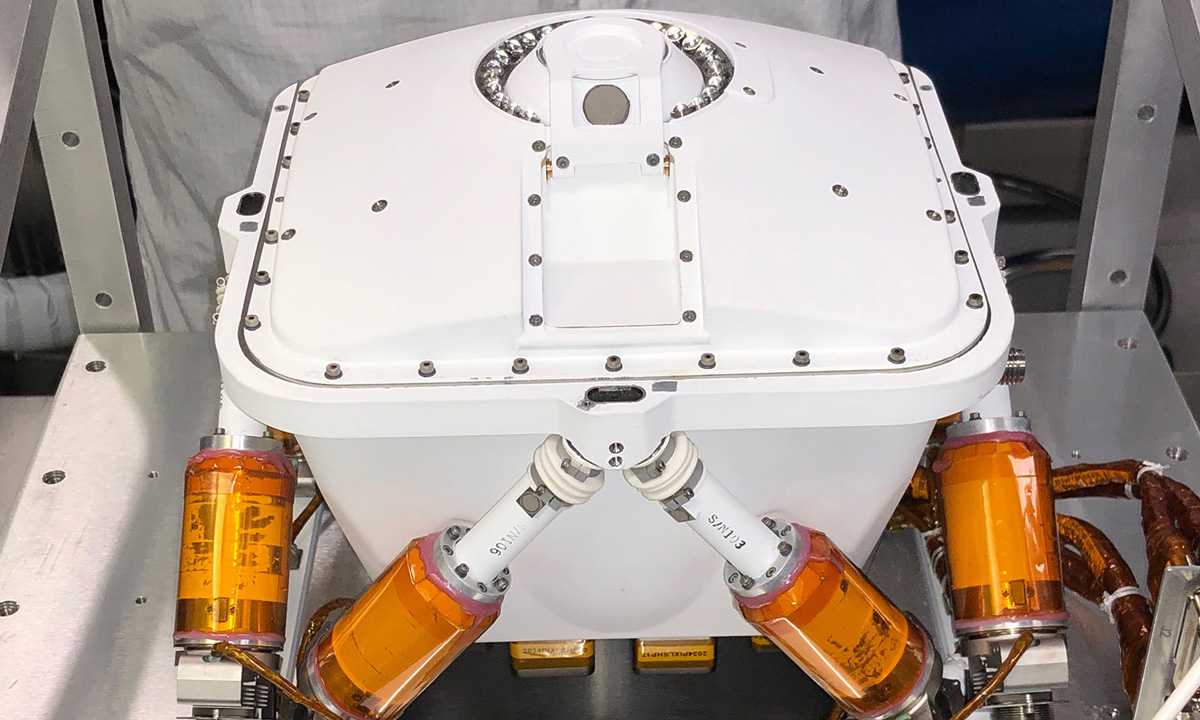
PIXL’s sensor head before being integrated with the robotic arm at NASA’s Jet Propulsion Laboratory in Pasadena, California. Image courtesy of NASA/JPL-Caltech.
To develop the 3D printed components, NASA worked with its Jet Propulsion Lab (JPL) at the California Institute of Technology (Caltech) to achieve PIXL’s lightest weight. The JPL team turned to metal AM service provider Carpenter Additive to print the instrument’s two-piece titanium shell, a mounting frame, and two support struts. Traditional manufacturing would have yielded end parts with three or four times more mass than 3D printed ones. PIXL’s lead mechanical engineer at JPL, Michael Schein, even said, “3D printing made this instrument possible” by allowing the team to achieve a low mass and high-precision pointing that could not be made with conventional fabrication.
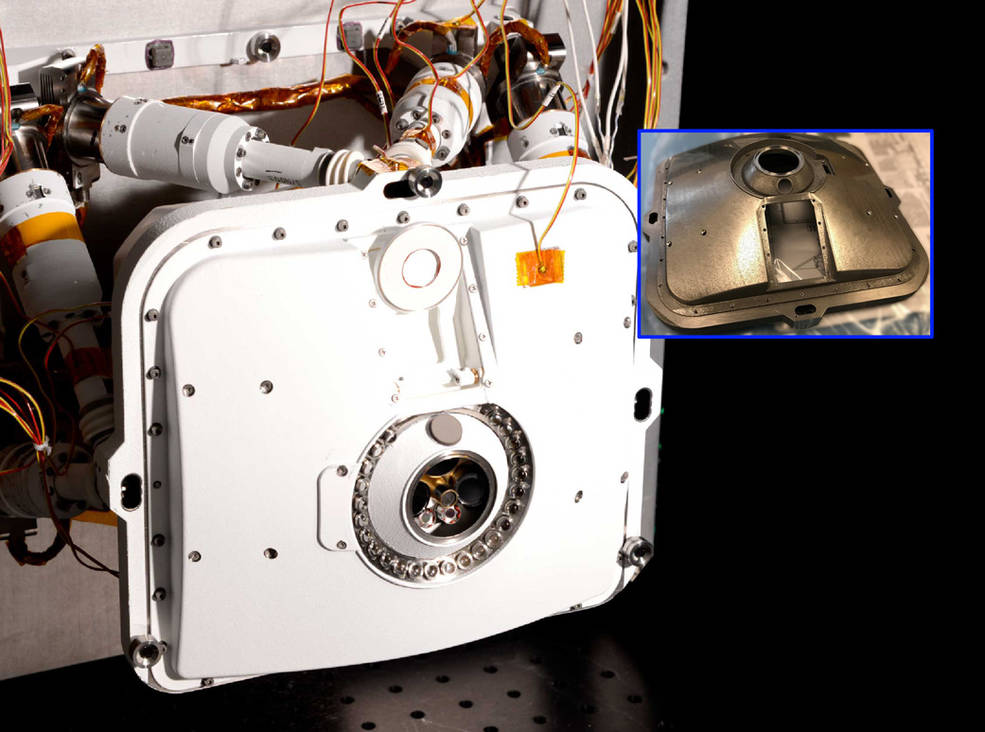
The outer shell of PIXL, one of the instruments aboard NASA’s Perseverance Mars rover, includes several parts that were made of 3D printed titanium. Image courtesy of NASA/JPL-Caltech.
As part of the U.S. space agency’s exploration of 3D printing technologies to build rocket engines, create spacecraft parts, and develop potential orbital outposts off-Earth, Perseverance has been equipped with a total of eleven 3D printed metal parts. This should come as no surprise, considering its predecessor Curiosity was the first mission to take 3D printing to the Red Planet, landing in 2012 with a 3D printed ceramic part inside its oven-like Sample Analysis at Mars (SAM) instrument.
NASA has since continued to test 3D printing for use in spacecraft to make sure the reliability of the parts is well understood. The agency has suggested that as “secondary structures,” Perseverance’s printed parts wouldn’t jeopardize the mission if they failed to work as planned, but as Andre Pate, the group leader for AM at JPL, said, “Flying these parts to Mars is a huge milestone that opens the door a little more for additive manufacturing in the space industry.”
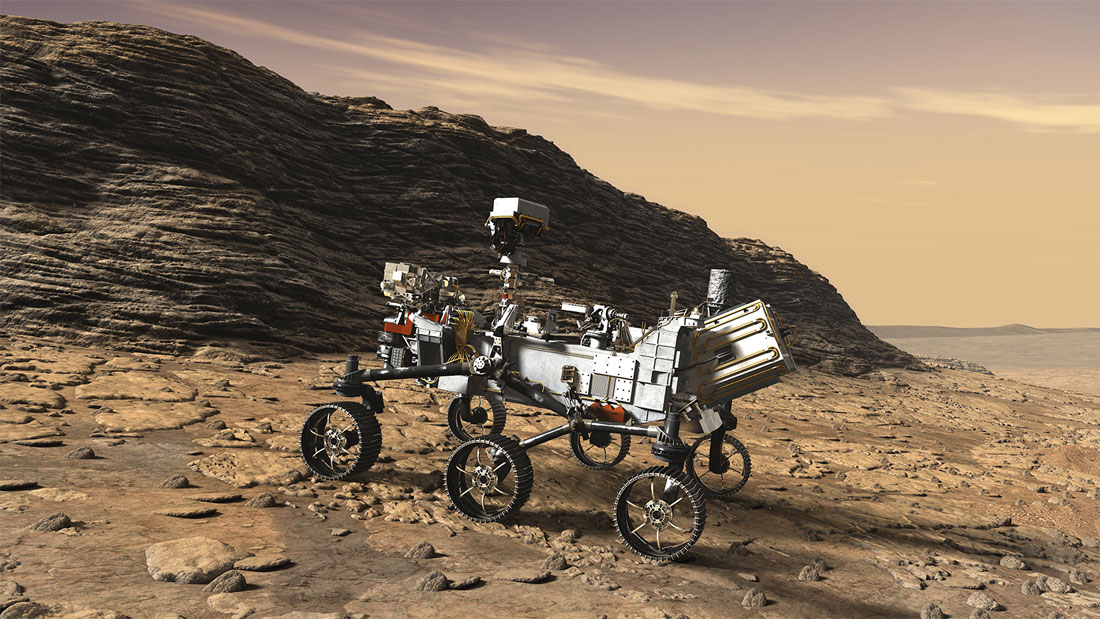
NASA’s Mars Persevarance rover will look for signs of life on the Red Planet. Image courtesy of NASA/JPL-Caltech.
However, it seems NASA is doing much more than opening a door for 3D printing. In the last eight years, it has taken up several related tasks, including the Rapid Analysis and Manufacturing Propulsion Technology (RAMPT) project to advance the development of AM techniques for printing large scale rocket engine parts using metal powders and lasers and partnering with companies like Stratasys to create optimized 3D printed structures for satellites. NASA even allowed astronauts aboard the International Space Station (ISS) to test 3D printing technologies in zero gravity, thanks to five platforms developed in collaboration with Made In Space, Tethers, 3D Bioprinting Solutions, and nScrypt, which have been successfully deployed and utilized in orbit.

MOXIE instrument lowered into the belly of the Perseverance rover. Image courtesy of NASA/JPL-Caltech.
The latest in a series of Mars rovers, Perseverance carries six other 3D printed parts in another one of its instruments. The Mars Oxygen In-Situ Resource Utilization Experiment (MOXIE) is a device that will test technology that could potentially produce industrial quantities of oxygen to create rocket propellant on Mars, helping astronauts launch back to Earth. While a conventionally machined heat exchanger would need to be made out of two parts and welded together, MOXIE’s were each 3D printed as a single piece at Caltech.
The latest Red Planet technologies are nearing a fascinating time for space exploration. Ingenuity’s upcoming first flight will open new possibilities and challenges for the future of off-Earth aerial exploration. Nonetheless, before Ingenuity takes its first flight on Mars, it must be squarely in the middle of a chosen flat “airfield” patch. Then, the elaborate process to deploy the helicopter on the surface will take about six sols, that’s six Earth days. The team will then spend up to 30 Martian days, or 31 Earth days, doing everything possible to ensure a successful flight, including wiggling the rotor blades and verifying the performance of the inertial measurement unit.
“As with everything with the helicopter, this type of deployment has never been done before,” said Farah Alibay, Mars Helicopter integration lead for the Perseverance rover, during the virtual briefing. “Once we start the deployment there is no turning back. All activities are closely coordinated, irreversible, and dependent on each other. If there is even a hint that something isn’t going as expected, we may decide to hold off for a sol or more until we have a better idea what is going on.”
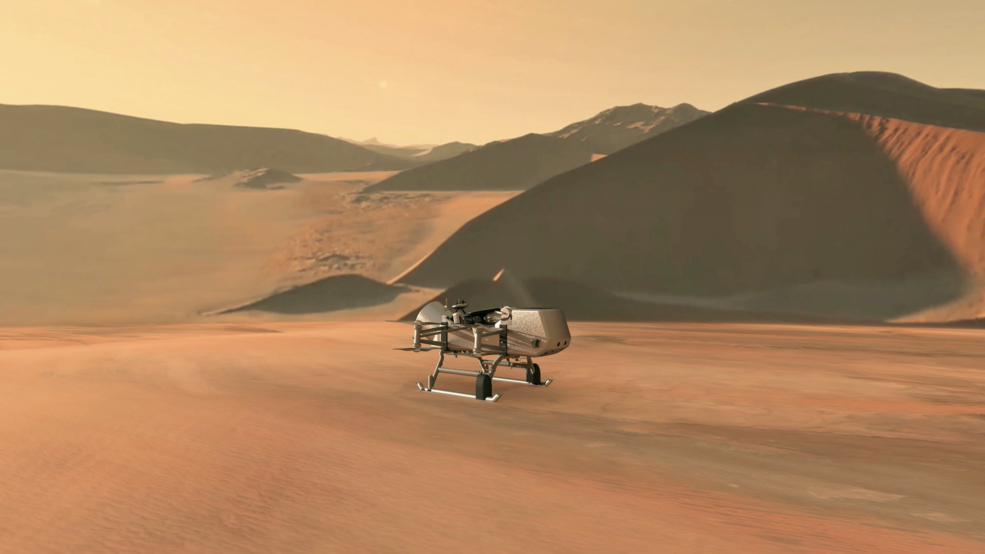
An illustration showing NASA’s Dragonfly rotorcraft-lander approaching a site on Saturn’s exotic moon, Titan. Image courtesy of NASA/JHU-APL.
Subsequent NASA missions to Mars, the Moon, and beyond are already in the works. The director for planetary science at JPL, Bobby Braun, said, “if we can scout and scientifically survey Mars from the air, with its thin atmosphere, we can certainly do the same at several other destinations across the solar system, like Titan or Venus.” Actually, targeting 2027 for its Dragonfly mission, NASA plans to send a rotorcraft to Saturn’s moon Titan to advance further search on the building blocks of life.
Nevertheless, in the more immediate future, we can expect to see the Artemis program taking giant leaps by sending astronauts to the Moon in 2024 (a timeline many have deemed unrealistic) and later on to Mars. In preparation for the mission, the space agency has a concept for the core surface elements needed to establish a sustained presence in space, and is investing in advanced manufacturing, considered one of five industries of the future to enable space exploration. For a moon mission, however, the critical lander craft is essential to take people from lunar orbit down to the surface and back up. That alone has already opened up a range of possibilities for 3D printing to outperform other technologies. To learn more about all of the 3D printing that’s going into the future of space travel, visit 3DPrint.com’s new Space Zone.
Subscribe to Our Email Newsletter
Stay up-to-date on all the latest news from the 3D printing industry and receive information and offers from third party vendors.
You May Also Like
UpNano Launches 2PP 3D Printing Service with New NanoPro VT Printer
UpNano, an Austrian company specializing in two-photon polymerization (2PP) additive manufacturing (AM), has launched a service bureau that will offer high-volume output of microscale parts. The new service, NanoPro, will...
Materialise Updates Magics and Partners with BLT at Formnext 2024
At this year’s Formnext, 3D printing software and services pioneer Materialise, unveiled a series of software updates designed to enhance customization capabilities in 3D printing for its users. The announcement...
HP’s New Materials, Tools, and Collaborations to Drive 3D Printing Forward at Formnext 2024
At Formnext 2024, HP unveiled several key developments aimed at advancing additive manufacturing (AM), with new materials, workflow optimization tools, and expanded metal printing capabilities. These announcements reinforce HP’s strategy...
Farsoon at Formnext: What’s New in 3D Printing for 2024
With Formnext 2024 underway in Frankfurt, Farsoon Technologies (SHA: 688433) is showcasing a series of developments unveiled in the lead-up to the event. From advancing food-safe 3D printing for the...




































